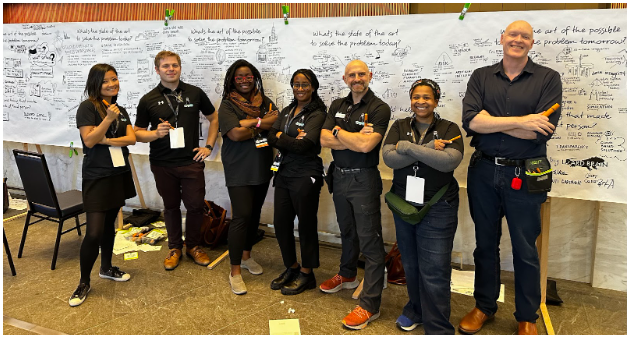Techstock Case Study: how to capture 300 participants’ ideas in two hours
40 foot Graphic Recording by Lizard Brain
I’d provided graphic recording services for Techstock before, but it was still a pleasant surprise when Aimee, the Techstock executive director, contacted me for their event in October 2024. “Like last year, we’re bringing together special operations folks and techies to work together, mash up ideas, and come up with new innovations,” she said, “but what’s different from last year is that we’re not doing it in breakout groups. It’ll be on November 1, 2024. We’re calling it an ‘operational strategy session.’ About three hundred participants will all work together in the same large room simultaneously. And we want you to graphic record their ideas. Your illustration has to be done at the end of the two hour session, when we’ll invite teams to brief out what they came up with from your graphic recording.”
Graphic recording is live illustrated note taking. It’s usually drawn out on sheets of paper that are about 4’ tall by 8’ to 10’ wide. We tape the paper to smooth walls when walls are available; we use folding, freestanding easels when walls aren’t an option.
Graphic recording depends on being able to listen and hear what’s happening in the room. It’s perfect to capture notes from presentations, lectures, panel discussions, and keynote speeches. But graphic recording can’t capture dozens of simultaneous conversations at the same time, simply because a graphic recorder can’t hear them all or illustrate that quickly.
Fortunately, there’s a good solution for the problem of tracking many simultaneous conversations: Wisdom Walls. Wisdom Walls put the responsibility of listening on the participants. Participants write their ideas onto index cards or sticky notes, which are then passed to the graphic recorder to transcribe.
Wisdom Walls aren’t a foolproof process: the ideas come to the graphic recorder without context, making it difficult to understand how they fit into the larger conversation. They only work if participants write their ideas, and do so legibly. And participants often over-capture, writing much more than necessary to relay the key points of an idea. Transcribing ideas takes time, and with potentially three hundred people writing ideas, it would take a lot of time: a lot more than two hours.
Transcribing participants’ notes to a Wisdom Wall
Wisdom walls take the pressure of listening and remembering content off the graphic facilitator by capturing ideas on notes.
Going on past experience, I figured that a single Wisdom Wall could capture the ideas of about fifty or sixty participants. That meant I’d need five Wisdom Walls to capture the ideas of three hundred participants. If each Wisdom Wall was eight feet wide, that meant I’d have to build a forty-foot wall.
The design for the wall was based on a first-generation Neuland wall. The five 4’x8’ panels would be EagleCell: a biodegradable high-end corrugated paper product. I made the legs out of red oak: an inexpensive and moderately hard wood. Including the glue and fasteners, the materials cost just under $400.
The supporting legs’ design were based on a first-generation Neuland wall
To avoid the whole thing tipping over if one of the graphic recorders leaned into it too hard, I added stabilizing sandbags to the horizontal legs.
I would need help to illustrate the forty-foot mural in just two hours. I put the call out to the network of graphic recorders and visual facilitators, and thankfully, a few colleagues were interested.
From left to right, Anne Owl, Paul Mackender, Ashanti Gardner, Elise White, me (Brian Tarallo), Shana Creech and Casey Creech.
I made the decision that we would capture the content in black and white. Color takes time, and we had to draw fast. How graphic recorders use color varies depending on the individual, so drawing in black and white would help us keep a consistent style. I’d had good results previously drawing in black and white, then adding color in post production once the chart was scanned.








